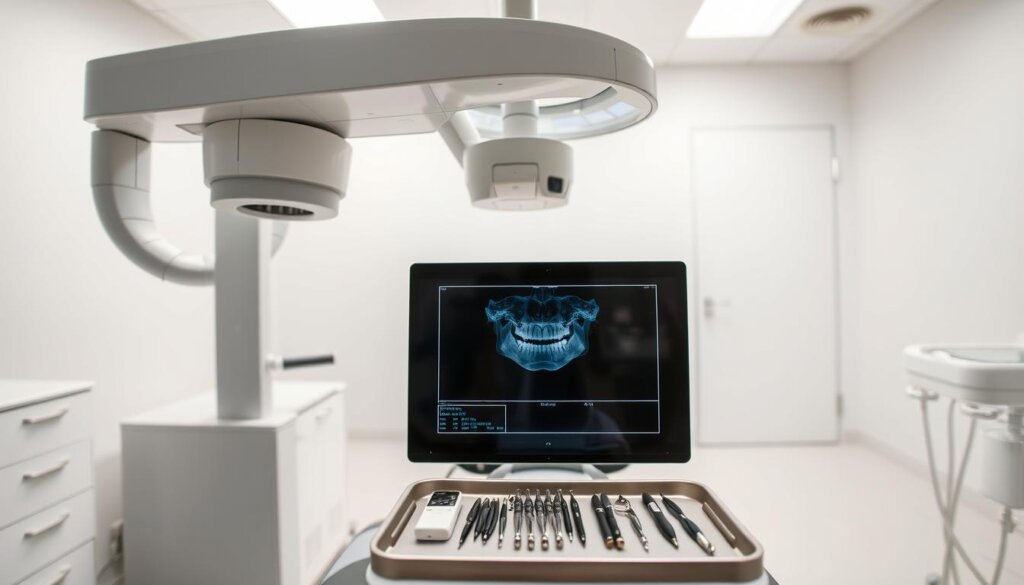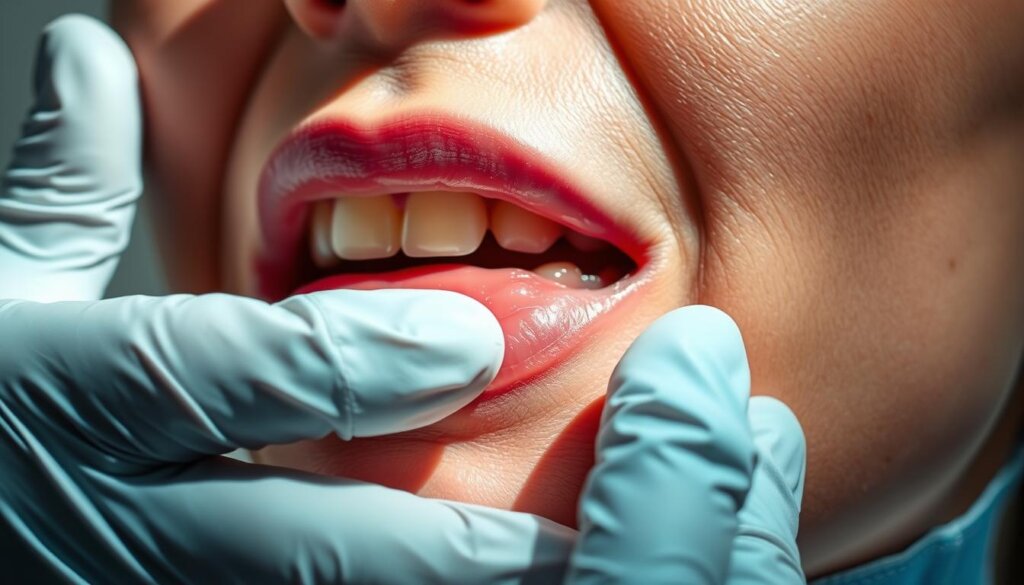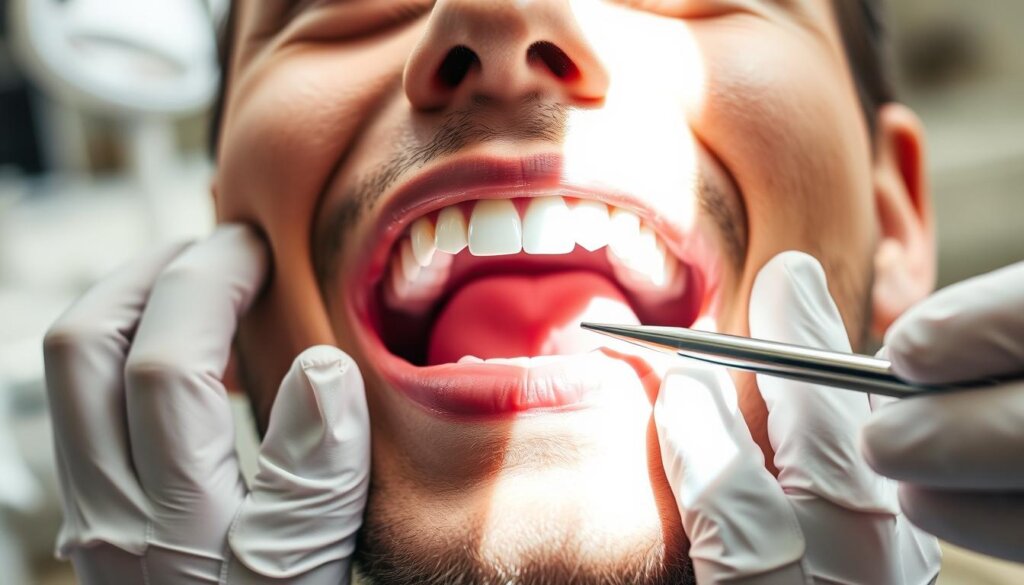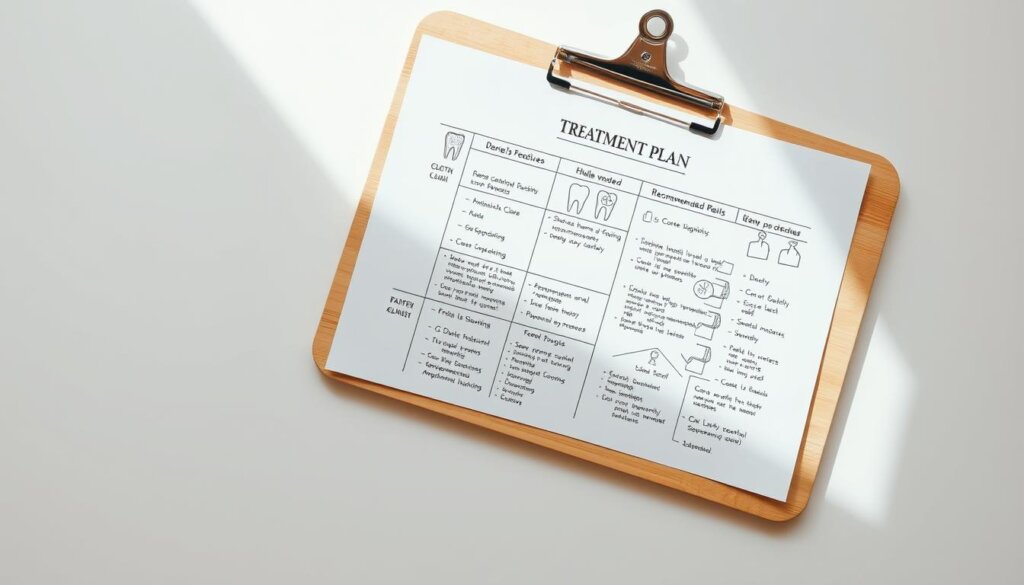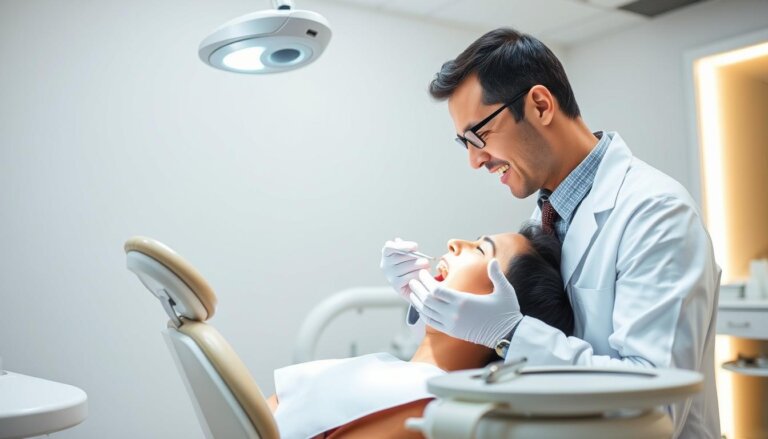What Do Dentists Look For During the Exam?
Many might not know this, but over 100 million Americans skip seeing a dentist each year. The American Dental Association sheds light on this. The mouth tells a lot about overall health. Dentists look for signs that go beyond just ensuring a great smile. An oral health examination can spot early signs of diseases like heart issues and diabetes.
At the dentist, the visit starts with a dental assistant or hygienist. They clean your teeth to remove tartar and plaque. This step is key before the dentist checks your teeth more closely. After cleaning, your teeth are polished to shine. Next, the dentist carefully checks your teeth, gums, and mouth area. They also look at X-rays for a deeper look and talk about how to keep your mouth healthy.
Dental visits do more than clean teeth. They combine a close look at your mouth with technical checks the dentist does. These visits every six months help prevent problems, find issues early, and plan treatment. This is based on your unique dental history and needs.
Key Takeaways
- An oral health examination can reveal signs of systemic diseases.
- The dental check-up process involves both cleaning and technical assessment by a professional.
- A thorough dental exam looks beyond the teeth to include gums and the entire oral cavity.
- X-rays play a vital role in diagnosing issues not visible to the naked eye.
- Discussing oral hygiene practices with a dentist is an integral part of the exam.
- Preventative care through regular dental visits is essential for long-term oral health.
The Importance of Regular Dental Exams
Getting regular dental exams is key to keeping your mouth healthy. These exams are super important not just for keeping your teeth clean, but also for catching problems early. When you follow a dental exam checklist with your dentist, you make sure your mouth stays in top shape.
Understanding the Purpose of Dental Check-ups
Dental check-ups are both preventive and diagnostic. Your dentist looks at your teeth, gums, and mouth to check their health. The main aim is to find any problems like cavities or gum disease early. This way, they can be treated more easily.
Frequency of Dental Visits
How often you should see your dentist varies, but going at least twice a year is a good rule. These visits let your dentist keep an eye on your oral health and address any issues quickly. Regular check-ups are crucial to spot any problems early and keep your mouth healthy.
Benefits of Preventative Care
Preventative care is the foundation of good dental health. It helps stop serious problems before they start, which keeps your mouth healthy and saves you money down the line. During these exams, dentists also teach you how to take care of your teeth every day.
Visual Examination of the Oral Cavity
Dentists use various teeth examination techniques during a check-up. These methods help find problems early and plan how to prevent them. We will look at the main steps of this exam. It checks for cavities, gum disease, and importantly, oral cancer screening.
Checking for Cavities and Tooth Decay: Each tooth gets a close look for decay signs. This could be holes, dark spots, or other unusual signs. Dental tools help dentists find soft spots, showing where cavities may be.
Signs of Gum Disease: The dentist will also check the gums for disease signs. They look for redness, bleeding, or gums pulling away from teeth, which suggest gum problems.
Oral Cancer Screening: The screening for oral cancer is crucial. The dentist checks the mouth, tongue, throat, cheeks, and lips for any strange sores or lumps. Early detection of oral cancer makes treatment more effective.
By examining mouths carefully, dentists protect against oral diseases. They also watch for any early signs of serious conditions. This means problems can be caught and treated early on.
X-Rays and Imaging Techniques
Dental X-rays are key in finding hidden issues in teeth and gums during check-ups. They let doctors see what can’t be seen with just a look, showing a full picture of your dental health. This is especially true for parts of the mouth that can’t be examined in a normal check-up.
Types of Dental X-Rays are varied, each with its own purpose. For up-close looks, intraoral X-rays are often used. But for a bigger picture of the jaw and skull, extraoral X-rays are the go-to. Panoramic X-rays, meanwhile, are perfect for seeing all of your teeth at once, helping in planning for braces, implants, or tooth removal.
These X-rays can uncover hidden issues like early-stage tooth decay, wisdom teeth that are stuck, and the health of the jawbone. Spotting these problems early is crucial in dealing with them effectively.
Lead Aprons and Safety Protocols protect patients during X-ray procedures. People wear lead aprons to keep safe from the small amount of radiation. X-ray techs follow tight safety rules to make sure the benefits of these tests outweigh any risks.
The insight from dental X-rays allows for precise treatments, maintaining great dental health. This highlights the goal of improving dental care and science.
Gum Health Assessment
When you go for a full dental check-up, checking your gum health is key. It’s a major part of staying ahead of mouth problems. This check-up can spot early signs of gum trouble and get you the help you need quickly.
Part of this process is a periodontal evaluation. Here, the dentist checks how deep your gum pockets are. The depth tells them a lot about your gum’s condition. Catching problems early helps keep your mouth healthy and avoids bigger issues later.
Measuring Gum Pockets
Doctors use a special tool called a periodontal probe to measure your gum pockets. This step is very important. It helps figure out how healthy your gums are and what treatment you might need.
Symptoms of Periodontal Disease
Look out for signs like swollen or bleeding gums, bad breath that won’t go away, and gums pulling back. Spotting these during a gum health assessment means you can start treating them right away.
- Watch for any changes in the color or swelling of your gums.
- Keep an eye on any bleeding when you brush or floss.
- Look out for gum pulling back or teeth that feel loose.
Evaluation of Bite and Jaw Alignment
Dentists check your bite and jaw alignment carefully during exams. They look for any problems that might affect your oral health. This includes searching for signs of malocclusion and TMJ disorders, which are key to finding deeper issues.
The bite analysis is all about seeing how your teeth fit together. An improper bite can make chewing hard, cause headaches, and lead to jaw pain. A jaw alignment check looks at how your jaw is shaped and positioned. It helps spot any off-balance that could worsen joint issues.
| Aspect | Normal Condition | Potential Issue |
|---|---|---|
| Bite Alignment | Teeth align neatly and evenly | Teeth are overcrowded or spaced irregularly |
| Jaw Position | Jaw aligns centrally, symmetrical movement | Misalignment leading to crooked jawline or uneven jaw movement |
| Temporomandibular Joint (TMJ) Function | Smooth, pain-free jaw movement | Clicking sounds, pain, or difficulty moving the jaw |
By doing bite analysis and jaw checks, dentists can give treatments that help with pain, improve how your mouth works, and stop more problems. This careful work is part of keeping your dental health the best it can be.
Oral Hygiene Evaluation
During a routine dental exam, checking oral hygiene is key. It helps keep not just the mouth, but the whole body healthy. Good oral hygiene stops many dental problems. Here, we explain how we check and what we find about oral care.
We use different methods to check how healthy your mouth is. We also give tips on how to take better care of it. Let’s look at what this examination involves.
Assessing Brushing and Flossing Techniques
It’s important to look at how a patient brushes and flosses. Many people don’t do it right, which can cause problems. Dentists take a close look and give advice on how to do it better. This helps get rid of plaque completely.
Identifying Plaque and Tartar Buildup
Finding plaque and tartar is a big part of the exam. If plaque turns into tartar, it can cause gum disease. Dentists use special tools to spot these problems early during the check-up.
| Common Issues | Advice Given |
|---|---|
| Incomplete plaque removal | Enhance brushing technique, focus on hard-to-reach areas |
| Insufficient flossing | Regular flossing, using correct tools and methods |
| Signs of early gum disease | Professional cleaning, improved daily care |
| Recurrent tartar buildup | Scheduled professional cleanings, daily tartar control products |
This evaluation is crucial for finding and stopping oral health issues early. By giving detailed tips and doing thorough reviews, we keep our patients’ mouths healthy. This shows our dedication to using our dental knowledge to educate and help patients.
Inspecting Dental Appliances
When you visit the dentist, they often check your dental appliances like braces or dentures. They make sure these tools work well and stay clean. This step helps keep your mouth healthy and makes your appliances last longer.
It’s very important to take good care of dental appliances. Now, let’s talk about how to maintain different types:
- Braces: It’s key to clean around the brackets and wires well. This prevents food and plaque buildup, which can harm teeth and gums.
- Aligners: You should rinse and clean them as your dentist instructs. This keeps them from getting stained and stops bacteria from growing.
We should also pay attention to dentures and implants:
- Dentures: You need to take them out and clean them every night. Use the methods and materials your dentist recommends to avoid damage and keep them clean.
- Implants: Regular dental visits are key. The dentist will check the implants for any problems and make sure the gums are healthy.
The condition of your dental appliances affects not just your mouth health, but your life’s quality too. Going for regular checks can help catch problems early. This saves you from pain, trouble, and extra costs. Basically, these inspections are very important for stopping dental problems before they start.
Discussion of Medical History
Reviewing a patient’s complete medical history is key when planning dental care. It helps find any health issues that could change dental treatments. Talking over health conditions fully during a dental visit ensures the best, safest treatment plan is made.
Knowing a patient’s past health issues and current meds helps dentists spot possible drug interactions. These could alter how well dental treatments work or risk safety during procedures. A good review of dentist appointment tips can greatly improve patient care and results.
- Preventing Complications: Conditions like diabetes or heart disease can affect how treatments work and their outcomes.
- Medication Interferences: Some common meds can change dental treatment plans due to effects on things such as bleeding or bone health.
- Customized Treatment Plans: Adjusting dental procedures to each person’s health conditions ensures they are safe and work well, making patients happier.
Dentists can give more complete care by understanding each patient’s medical background. This approach addresses not just immediate dental issues but also considers overall health. It helps dentists provide care that directly meets each patient’s unique needs.
| Aspect | Details |
|---|---|
| General Health Conditions | Discussion of any health conditions that might affect dental treatment. |
| Current Medications | Review of meds and supplements that might interact with dental treatments. |
| Allergies | Finding any allergies to drugs or materials used in dentistry. |
| Patient Concerns | Talking about any specific worries or fears related to dental work. |
Treatment Recommendations
After a full dental check-up, each patient gets a special dental treatment plan. It’s made just for them to meet their oral health needs. This plan is very important for keeping teeth healthy and avoiding future problems.
The plan includes both urgent treatments for fixing teeth and advice for ongoing oral care recommendations. This helps keep teeth healthy and looking good for years. Care plans are explained well, so patients get what treatments they need and why.
For example, if someone has early signs of tooth decay, they might get teeth bonding. This is a simple way to fix teeth and make them look good again, often mentioned in these plans.
- Initial Treatments: Immediate steps to take care of urgent issues like cavities, gum disease, or sudden dental problems.
- Preventive Measures: Routine cleanings, fluoride treatments, or sealants to stop tooth decay.
- Long-term Maintenance: Planning regular dental visits and checking if braces or other orthodontic care is needed.
In short, dental treatment plans focus not just on solving current problems. They aim to build lasting oral health. They go hand in hand with oral care recommendations that change as a patient’s needs do over time.
Patient Education
In dental care, teaching patients is key to good oral health. This part focuses on the need for regular oral care. It also gives tips on how to keep your teeth clean.
Importance of Ongoing Oral Care
Teaching about oral health is key to stopping dental diseases. Staying informed about dental health is important. It helps people make smart choices about their teeth.
Patients learn about the dangers of not taking care of their teeth. This includes gum disease, cavities, and other serious issues.
Tips for Maintaining Oral Health
Dental experts give helpful advice on keeping teeth clean. Here are some tips to improve your daily dental care:
- Brush at least twice a day with fluoride toothpaste to fight plaque.
- Use dental floss every day to clean where a toothbrush can’t reach.
- Avoid sugary snacks and drinks that cause tooth decay.
- Go to the dentist regularly for check-ups and cleanings.
- Think about using mouthwash to deal with plaque bacteria and freshen your breath.
Follow-Up Appointments
Follow-up appointments are vital for keeping your mouth healthy. They help check the success of past treatments and look for new issues. These check-ups are key to stopping problems before they start, helping you keep your mouth healthy for a long time.
When you go to regular dental visits, your dentist keeps an eye on your oral health. This means they can quickly deal with new problems. Finding issues early can stop them from getting worse, saving you from bigger problems later.
| Appointment Type | Purpose | Recommended Frequency |
|---|---|---|
| Initial Evaluation | Complete oral assessment | Upon first visit |
| Regular Check-Up | Continuous oral health monitoring | Every 6 months |
| Post-Treatment Follow-Up | Ensure effective treatment outcomes | As advised by dentist |
| Emergency Consultation | Immediate attention to acute issues | As required |
Going for dental check-ups is not just about fixing problems. It’s about caring for your health ahead of time. By making these appointments regularly, you are looking after your oral health. This preventive approach helps your teeth last longer and keeps your mouth healthy. Dentists can then give care that’s just right for you, adjusting as your dental needs change.
Understanding Dental Terminology
Teaching patients dental terms helps them understand their exams better. It makes them active participants in managing their oral health. This part explains common dental exam terms.
We aim to make dental visits less confusing by explaining common terms. Knowing these terms reduces anxiety and clears up any confusion about the treatments.
- Anamnesis – The patient’s medical history provided during the dental exam.
- Prophylaxis – A preventive treatment intended to clean the teeth and maintain oral health.
- Periodontitis – An advanced stage of gum disease that can lead to tooth loss and other serious health complications.
- Calculus – Hardened dental plaque, also known as tartar, that has bonded to the tooth surface.
- Caries – Commonly referred to as tooth decay or cavities.
- Malocclusion – Describes misalignment between the teeth when the jaws are closed.
Understanding dental terms turns patient care from passive to active. Patients make more informed health decisions. This knowledge improves communication with dentists and the care experience.
Conclusion: The Role of Dentists in Preventive Care
Dentists do more than just fix teeth problems. They are crucial in preventive dental care. They conduct thorough exams, from simple checks to advanced scans, to protect our teeth health ahead of time. This proactive approach prevents small issues from becoming bigger problems.
This not only deals with immediate teeth issues but also helps avoid future ones. By looking at oral health as a whole, dentists ensure we stay healthy overall.
Building a Trusting Patient-Dentist Relationship
A solid patient-dentist relationship makes preventive care work better. Trust leads to open talks, which are key for planning care that fits the patient. When patients feel listened to and valued, they’re more likely to follow advice and keep up with visits.
This can catch dental problems early. How friendly and clear a dentist is can really change how a patient views taking care of their teeth.
Long-Term Oral Health Goals
Thinking ahead about teeth health is essential. Dentists who aim for long-term health are like wise guides. They teach patients why keeping teeth healthy over time matters.
This helps patients see how what they do now affects their health later. Sharing this knowledge helps push medical science forward and tackles big health issues. It encourages patients to be in charge of their tooth care, making society healthier.

